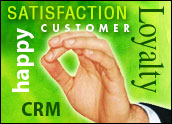
Perhaps the new slogan in this merciless economic downturn should be “All Hail the Salesman.” For it is the salesman that brings home the bacon upon which all other jobs will feed. It is key, then, to see to it that salespeople are equipped with the very best technologies and that they are supported without restraint. It is also crucial that salespeople adopt and use these tools to their full advantage lest they go all “Willie Loman” on us and wallow in a rant against the times rather than embrace the urgent call “to shape an uncertain destiny” issued by President Obama and trumpeted by company execs everywhere.
The best practices in CRM these days are crafted as a means of sheer survival; They are proactive rather than defensive. Begin with the understanding that sales is not a loner’s game, nor a one-way street.
“You have to be proactive and structured about how you engage with your customers,” Brad Wilson, general manager of Microsoft Dynamics CRM, told CRM Buyer. “The pool of people considering purchases is dwindling, so you have to make smart decisions about how you connect with them.”
Change from Peddling to Pleasing
First order of the day: Shift away from company-centric peddling to customer-centric satisfaction.
“Since the industrial revolution era began, most business models have been built around products and channels,” Jeff Gilleland, SAS customer intelligence product marketing manager, told CRM Buyer. “Everything has been organized around these company-centric elements to include organizational structures, management and incentive plans, financial systems, marketing mix elements and everything else that mattered. Yes, we all know those company slogans that focused on the customer were really about improving customer service, customer satisfaction, or some other very important quality or customer measure. But even to this day, the heart of most business models remains company-centric.”
Customer profiling, segmenting and targeting have long been used for direct marketing campaigns, advertising media planning and other sales and marketing activities. Essentially, customer segmentation has been used to support “product-push” marketing models, where emphasis is placed on identifying ideal purchasers of individual products, said Gilleland.
What’s changed? “Today, many companies are going beyond basic target marketing by using their sophisticated analytical and predictive capabilities to start first with customers, not products,” says Gilleland. “The goal is to determine which customers represent the best opportunities for long-term, profitable relationships.”
Gilleland said many companies begin with a strategic segmentation schema that scores customers on their current and potential profitability. They layer on other dimensions such as demographic, life-stage and attitudinal data. This enables companies to place customers into segments (or treatment tracks). “An enterprise-level customer segmentation schema then becomes the heart of the business model — enabling the company to build customer-centric business strategies — even in a product-centric organizational structure,” he said.
Customer segmentation is becoming a strategic priority. “It is becoming the foundation for key decision making. It’s being used to determine where to invest sales capacity and marketing dollars,” added Gilleland. “It’s enabling new organizational structures to emerge with new positions such as Customer Segment Managers and Chief Customer Officers (CCOs). And it’s enabling new, and more meaningful, metrics to be created around customers and segments of customers.”
Even small businesses can benefit from this approach. “CRM software can help segment customers in unique ways by looking at demographics, techno graphics, brand loyalty and purchase behavior,” Angie Hirata, worldwide director of marketing at Maximizer Software, a CRM provider for SMBs, told CRM Buyer. “For example, in a retail or manufacturing environment, Prosumers (highly sophisticated consumers) appreciate the chance for interaction with manufacturers, providers and retailers. They are often a very profitable customer segment that will spend more, and are less price sensitive. Identifying profitable segments and targeting them with unique, personal offerings through marketing campaigns will help increase revenue and build long-term, successful relationships.”
Get Up Close and Personal
Social media is taking on more importance in terms of capturing new sales. Any company is far more likely to learn buying hot buttons from the free flow of conversations found in social media than they are from customer responses to the structured prompts emitted from their own channels.
“Sales teams can better prepare for sales calls by following a prospect’s online conversations on their blog, in Facebook or Twitter,” Pamela O’Hara, cofounder and president of BatchBlue Software, told CRM Buyer. “And they can better nurture the emerging relationships by recording conversations happening online and off. Trustworthy corporate participation in social media such as Facebook, Twitter and a blog leads to a much higher quality of prospects and can easily be tracked to lead generation and conversion.”
While tracking and leveraging all this information may seem a daunting task, technology exists to tame the flow. Gilleland said that as the blog world expands, text mining technologies are being put to work to learn from this expanding channel of knowledge. Text mining technology can identify patterns and enable sophisticated analytics to systematically gain knowledge from these text-rich portals, now numbering over 71 million active blogs and counting.
“Analyzing and predicting customer behavior is becoming the new currency,” said Gilleland. “It’s enabling managers at all levels in multiple industries to make smarter decisions. And because much of this knowledge is created at the customer level, today’s predictive analytics are enabling companies to become more customer-centric — understanding and responding to customer needs one-to-one.”
It is essential to fold social media into your CRM program. The days of relying solely on sales force automation or contact management are long gone.
“Sales functions in CRM must go far beyond simple Sales Force Automation (SFA) and be fully integrated in cradle-to-grave processes to return the investment,” Esteban Kolsky, vice president and practice leader at eVergance, told CRM Buyer. “The most important thing to do when deploying the sales components of a CRM system is not to think of it as a stand-alone pipeline and contact management. That is error No. 1.”
CRM Primed for Sales
In sales, there are several key elements for success. It is important to review your CRM program regularly to ensure it is performing up to par and that it incorporates the touchstones for key integration uses. Dan Byrnes, vice president of industry product strategy at Oracle, names the following as the key CRM elements you should currently have in place:
- Campaign Management — Have structured/standardized processes, post campaign assessments, and lead qualification in place to ensure success.
- Territory Management — Ensure there are centralized rules in place for optimizing sales territories to meet sales quota and sales territory realignments — in order to maximize sales resources.
- Sales Methodology — Follow a standardized selling process across the organization. Further, by streamlining the offer creation and order capture processes, companies can increase competitiveness and customer profitability. For example, communications service providers leverage CRM tools to match up-sell and cross-sell recommendations with customer data to present the right offer to the right customer at the right time.
- Channel/Partner Management — Provide special pricing authorization for partners, deal/design registration for partners, and provide a partner portal.
- Forecasting — Attain better accuracy in sales forecasting through quota attainment, support for sales overlays, and improved financial reporting.
- Sales Productivity — Offer wide access to CRM data across multiple touch points, including mobile, desktop, e-mail, client and Web interfaces. It is also important to be able to quickly interact with commonly used CRM data via these same touch points. For example, in service industries such as the communications industry, providers are expanding to alternate channels to enable field sales and facilitate the use of self-service tools.
- Document Generation — Standardize on proposal and quote generation and put workflows in place for variable approval generation and data recording in CRM.
- Integrations to External Sources of Data — Look for pre-built, sustainable integrations between CRM and external sources like order fulfillment systems, demand planning, sales and operations planning, financial planning, and incentive compensation engines to reduce integration costs.
Add the Sales Rep Back to the Sales Formula
Netting more sales is not accomplished through the mere use of smart and sophisticated technology. If social media has taught us anything, it is that human interaction is the one element that must exist for a sale to be made — even if the actual purchase is made through technological means alone.
In a nutshell, this is the time to elevate sales to an honorable and front position and to encourage sales behavior from every employee in the company, which means compensating non-sales personnel for the sale when they land a deal.
“Compensation plays a significant role in non-sales positions performing sales functions, such as cross-sell or up-sell, in customer service operations, but nothing kills incentives to sell faster than an improperly paid-out commission or, worse, no commission,” said Kolsky. “Make sure you sales incentives modules extend to accommodate all employees that are eligible, and that they perform all necessary functions quickly and efficiently.”
Last but not least, don’t reduce your sales force to working on commission only. While commission-only pay led to Willie Loman’s demise in “Death of a Salesman,” getting chintzy on sales rep pay these days can lead to “Death of a Company.” You must pay sales reps enough to survive through the elongated sales cycles of today.























































